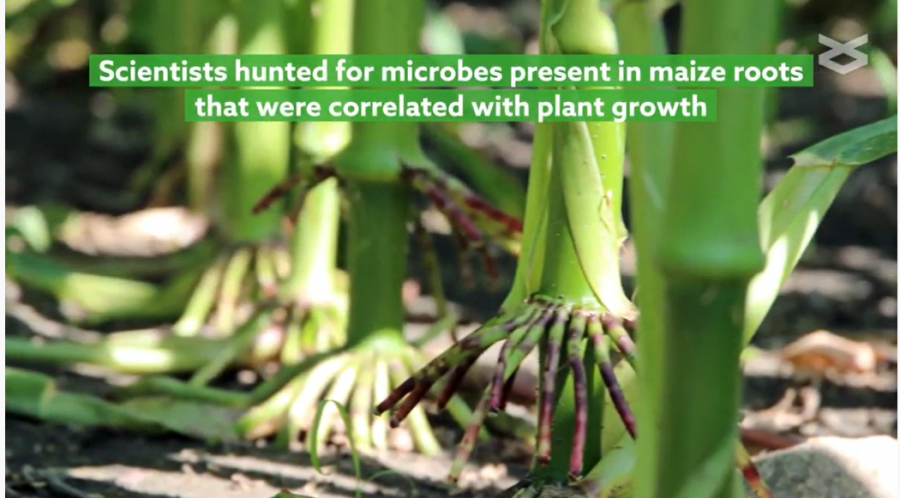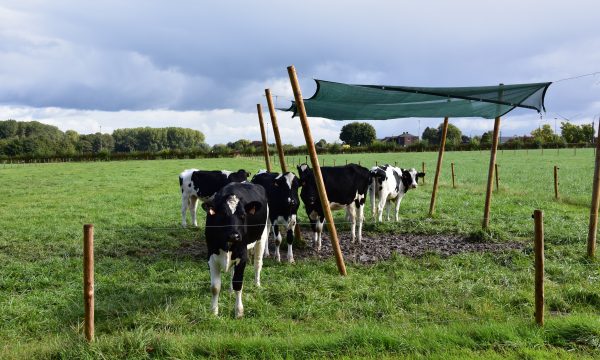Press release Fertilization and disease control via soil bacteria?

Bacteria that can improve maize growth under cold temperatures and bacteria that can limit the effects of a fungal infection with Rhizoctonia solani were discovered by ILVO-VIB researcher Stien Beirinckx using the metabarcoding technique. With this knowledge, researchers can start 'programming' the bacterial root community - the root microbiome - to reduce stress and promote growth in maize. This is the start of a new, promising area of knowledge with the hope of agriculture with fewer external inputs.
Soil bacteria for protection
"We have selected naturally occurring bacteria that have a strong link with maize and have a plant growth-promoting effect either under cold conditions or with fungal infection," says Stien Beirinckx. "The next step is to further unravel the mechanisms of action and colonization strategies of these bacteria. Eventually, we want to treat seeds with these bacteria in advance in order to improve germination in spring, when it can still be quite cold. We also hope that the development in the juvenile phase will then be faster and that the susceptibility to disease will be reduced".
We have selected naturally occurring bacteria that have a strong link with maize and have a plant growth-promoting effect either under cold conditions or with fungal infection
Agricultural crops are experiencing more and more stress
Due to global warming and the predominance of monocultures in our current agricultural system, agricultural crops are experiencing increasing stress, such as increased disease pressure and more extreme weather conditions. A new approach that makes use of different and new farming methods is required. An oft-suggested solution is the use of bacteria as a biological fertilizer and control product. But in order to understand and predict their effect, we first of all need a good knowledge of the existing bacterial communities in and around plant roots, and their effect on plant growth. VIB-ILVO researcher Stien Beirinckx took up this challenge for maize: she searched for and found bacterial strains that can promote maize growth under cold conditions (e.g. a chilly spring) or in case of infection by the harmful fungus Rhizoctonia solani. "It should not be forgotten that maize is actually a subtropical crop, and therefore particularly sensitive to cold, especially during germination and juvenile growth", explains the researcher. "That's why maize is planted quite late, but it also severely limits the growth period. Soil bacteria that protect young plants can make the difference: a longer growing season and healthier plants provide more yield'.
Mapping soil bacteria
Using high-tech techniques, so called metabarcoding, the researcher mapped the bacteria present and isolated them from between the maize roots and from the surrounding soil. In controlled bioassays, developed by the VIB-UGent Centre for Plant Systems Biology and ILVO, it was investigated how these microbes can stimulate plant growth. Two commonly used methods to analyze metabarcoding experiments were compared: an Operational Taxonomic Unit (OTU) method and an Amplicon Sequence Variant (ASV) method. Both methods were used to analyze three datasets: a dataset with soil samples, a dataset with maize root samples and a third simulated dataset. Both analyses were compared on the obtained diversity, richness, differential changes and taxonomic differences in the datasets. It was shown that the ASV method is the best option to obtain an overview of the microbial communities in the samples used. In addition, the analysis contained fewer errors when performed at the family level.
After fine-tuning the analysis methodology, the bacterial communities of the maize root were investigated in more detail. Families were detected that always colonize the maize root, but also families that react more strongly to cold temperatures: some became more abundant in cold conditions, others - streptomycetes for example - were less abundantly present. This effect was found to be stronger between the roots than in the surrounding soil.
Detecting plant helpers
Part of the collection of soil bacteria was tested for growth promotion in maize at cold temperatures. Based on this screening, two bacterial strains were detected that improved the growth of maize at cold temperatures. The underlying mechanisms of action and colonization strategies are not yet known and need further investigation.
Bacteria were also detected that can lower the disease symptoms of R. solani in maize. For this purpose the bacterial strains in the collection were screened for two known biocontrol mechanisms, namely direct antagonism of the fungus and induction of jasmonate signalling in the plant. In the first mechanism, the bacterium directly counteracts the fungus, in the second the bacterium stimulates a hormone reaction in the plant, so that it can organize its own defense. A selection of the bacterial collection, based on the results of both screenings, was subsequently tested for a biocontrol effect against R. solani in maize grown in greenhouses. This yielded promising results; the underlying mechanism of action is still being investigated.
Application in practice?
The results of this doctoral research provided a better understanding of the bacterial communities in maize root, and showed that these communities change at colder temperatures. This knowledge, together with the established collection, can give a significant boost to the identification, selection and application of growth promoting strains. Both bacteria were identified that can improve maize growth under cold conditions or suppress the disease symptoms of Rhizoctonia solani in maize. With this knowledge, researchers can now start 'programming' the bacterial root community - the root microbiome - to reduce stress and promote growth. In the (longer) term, this could lead to a new commercial biological product for application in agriculture. This could, for example, take the form of a seed coating that can improve germination in the spring, accelerate development in the juvenile phase and reduce disease susceptibility.


